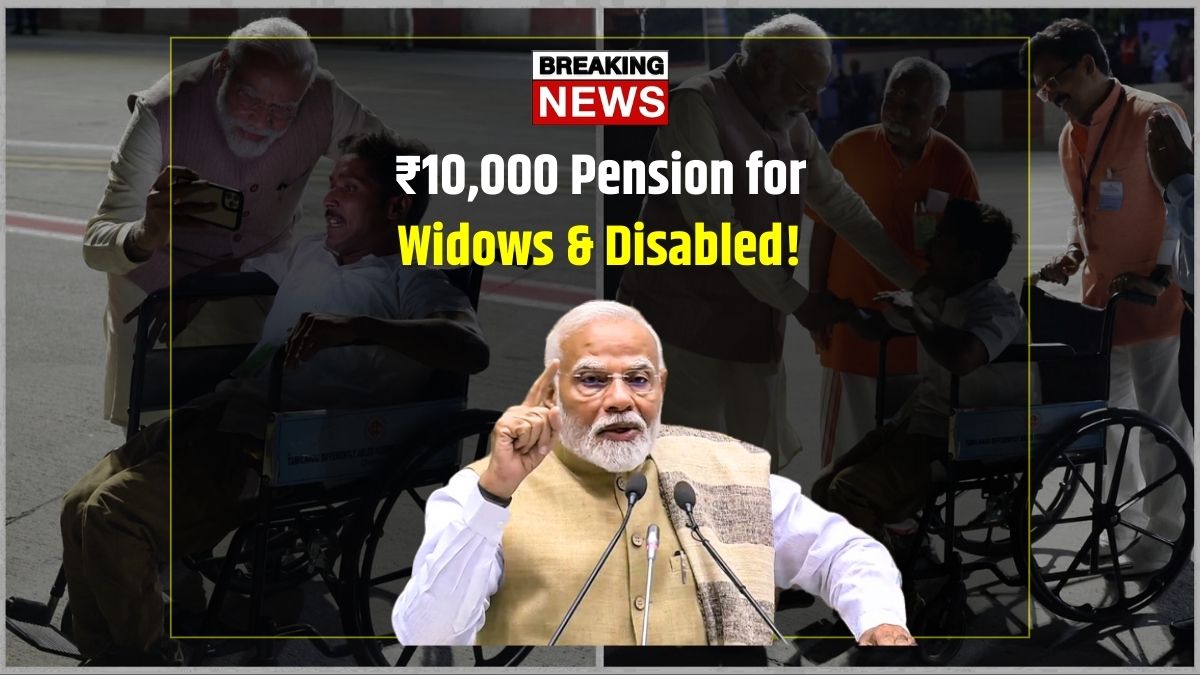New Pension Rules – The government has announced a significant increase in the monthly pension for widows and disabled individuals, marking a historic shift in the support for some of the most vulnerable sections of society. Under the newly updated pension rules, eligible widows and people with disabilities can now receive up to ₹10,000 per month. This hike aims to provide better financial security and improve the quality of life for those who often face economic hardships. Let’s dive into the details of these new changes and how they can benefit millions of people across the country.
What’s Changed in the New Pension Rules?
The latest reforms to the pension system are designed to strengthen the social security net for widows and individuals with disabilities. The government has increased the monthly pension amount, making it easier for beneficiaries to live with more financial independence and dignity. Here are the key features of the updated rules:
- Pension Amount: Widows and persons with disabilities will now receive up to ₹10,000 per month.
- Direct Bank Transfers: To ensure efficiency and transparency, the pension will be directly transferred to the beneficiary’s bank account.
- No Middlemen: The introduction of Direct Bank Transfers (DBT) eliminates the need for intermediaries, reducing the chance of delays and corruption.
- Simplified Eligibility Criteria: The eligibility requirements have been relaxed, making it easier for more people to access the benefits.
- Priority for Senior Citizens and Severely Disabled Individuals: People over the age of 60 and those with high disability percentages will be given preference in the application process.
Who Can Get the ₹10,000 Pension?
To qualify for the new pension scheme, applicants need to meet certain criteria. The eligibility guidelines have been expanded to cover more people, ensuring a broader reach:
- Widows: Women aged 18 years and older who have lost their spouse can apply for this pension scheme.
- Persons with Disabilities: Those who have a disability of 40% or more, as certified by a competent authority, are eligible for the pension.
- Income Limit: The applicant’s family income should not exceed ₹2 lakh annually.
- No Overlapping Benefits: Applicants should not already be receiving similar benefits from other government pension schemes.
- Bank Account with Aadhaar: To receive payments, applicants must have a bank account linked with their Aadhaar number.
How to Apply for the New Pension?
The application process has been simplified to make it easier for beneficiaries to apply and receive the pension without unnecessary delays. Here’s how you can apply for the new pension scheme:
- Visit the State Welfare Department Website: Each state has its own online portal where you can apply for the pension.
- Fill Out the Application Form: Download or fill out the application form online.
- Submit Documents: Attach necessary documents like your disability certificate, widow certificate, income proof, and Aadhaar card.
- Submit the Form: After filling out the form, submit it either online or visit your nearest welfare office.
- Track Application Status: Once submitted, you can track the status of your application online using the acknowledgment number provided.
Documents You Need
To make sure the application process goes smoothly, here are the documents you will need:
- Aadhaar Card
- Disability or Widow Certificate
- Bank Account Details
- Income Certificate
- Recent Passport-size Photograph
- Residential Proof
Benefits of the ₹10,000 Monthly Pension
The enhanced pension is designed to provide much-needed financial support to widows and disabled individuals. Here’s a look at the major benefits of this new scheme:
- Assured Monthly Income: The increased pension helps meet daily expenses, reducing dependency on others.
- Access to Basic Needs: With ₹10,000 every month, beneficiaries will find it easier to afford food, healthcare, and shelter.
- Improved Well-being: The extra financial support promotes a better quality of life and reduces stress related to financial hardships.
- Increased Independence: Beneficiaries will be able to live more independently without relying heavily on family or friends.
Old Pension vs New Pension: A Clear Difference
The new rules bring a massive upgrade compared to the old pension amounts. Below is a comparison of the old and new pension figures:
| Category | Old Pension Amount | New Pension Amount |
|---|---|---|
| Widows (below 60 years) | ₹2,000 – ₹3,000 | ₹10,000 |
| Widows (above 60 years) | ₹3,500 – ₹4,000 | ₹10,000 |
| Persons with 40-60% disability | ₹2,500 | ₹10,000 |
| Persons with 60-80% disability | ₹3,500 | ₹10,000 |
| Persons with above 80% disability | ₹4,500 | ₹10,000 |
| Senior citizens (widows/disabled) | ₹3,000 | ₹10,000 |
| Income Eligibility Limit | ₹1 lakh annually | ₹2 lakh annually |
As shown, the new pension amount is significantly higher than the previous figures, making a real difference in the lives of beneficiaries.
How Will This Pension Impact Society?
The increase in pension amounts will have several positive effects on both the individuals receiving the pension and society as a whole:
- Social Impact: The new pension scheme empowers widows and disabled individuals, giving them greater control over their finances and improving their quality of life.
- Economic Impact: By increasing the spending power of vulnerable sections of society, local economies will benefit as people will be able to spend more on goods and services.
- Psychological Impact: Financial security helps reduce mental stress, enabling recipients to feel more independent and confident.
Additional Benefits by States
Some states have introduced additional benefits to complement the ₹10,000 pension, further supporting widows and disabled individuals:
- Delhi: Free health insurance up to ₹5 lakh.
- Maharashtra: Subsidized housing schemes for disabled people.
- Tamil Nadu: Educational scholarships for disabled youth.
- Uttar Pradesh: Monthly grocery and nutrition kits.
- Kerala: Free medical checkups every quarter.
- Rajasthan: Priority loans for small businesses.
- Gujarat: Travel concessions on public transport.
What’s Next for Pension Expansion?
The government is also looking into further reforms to enhance the pension system:
- Healthcare Integration: Plans to integrate pension with healthcare schemes are underway.
- Automatic Pension Updates: Future revisions could ensure pension amounts are adjusted for inflation.
- Digital Pension Cards: A digital card could make accessing pension benefits easier for beneficiaries.
In conclusion, the government’s decision to increase the pension to ₹10,000 per month for widows and disabled individuals is a major step forward in ensuring financial security and dignity for those who need it most. With the new rules, millions of people will benefit from greater financial independence and a better quality of life. If you or someone you know is eligible, it’s important to apply soon to make the most of this opportunity.




